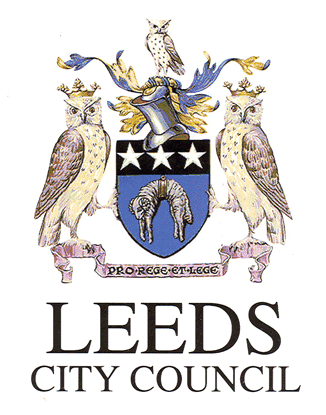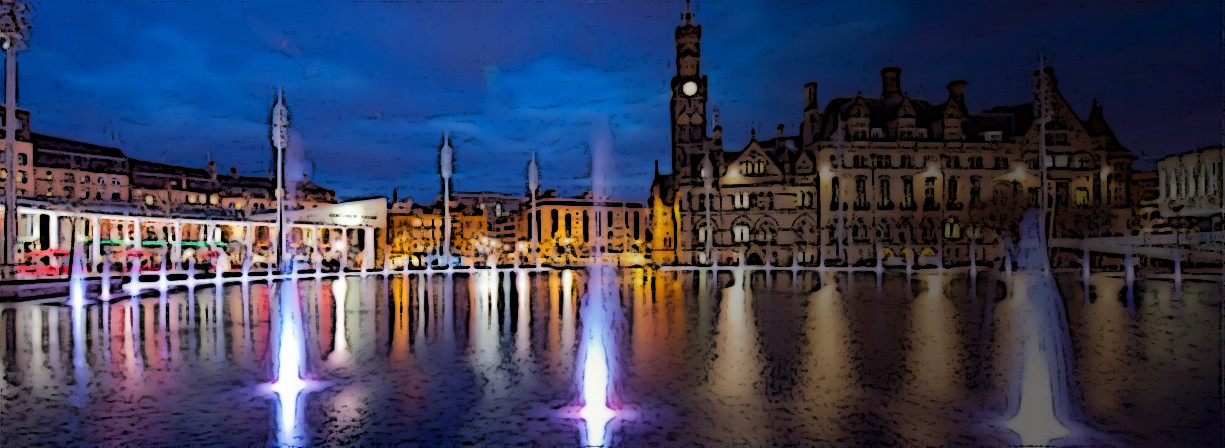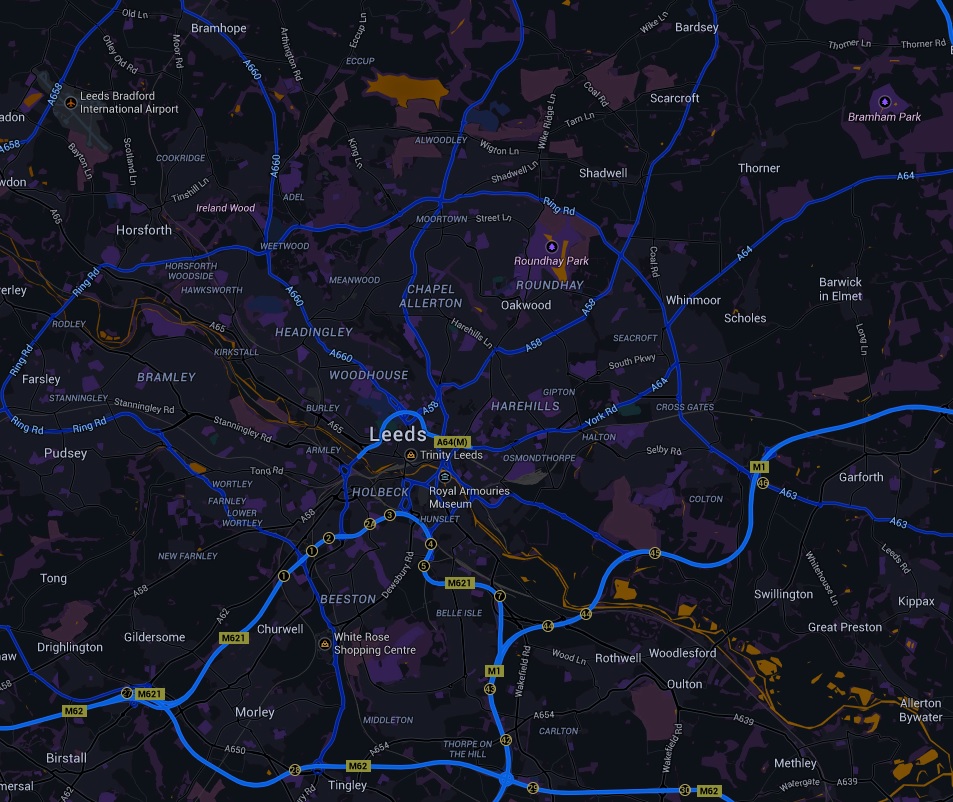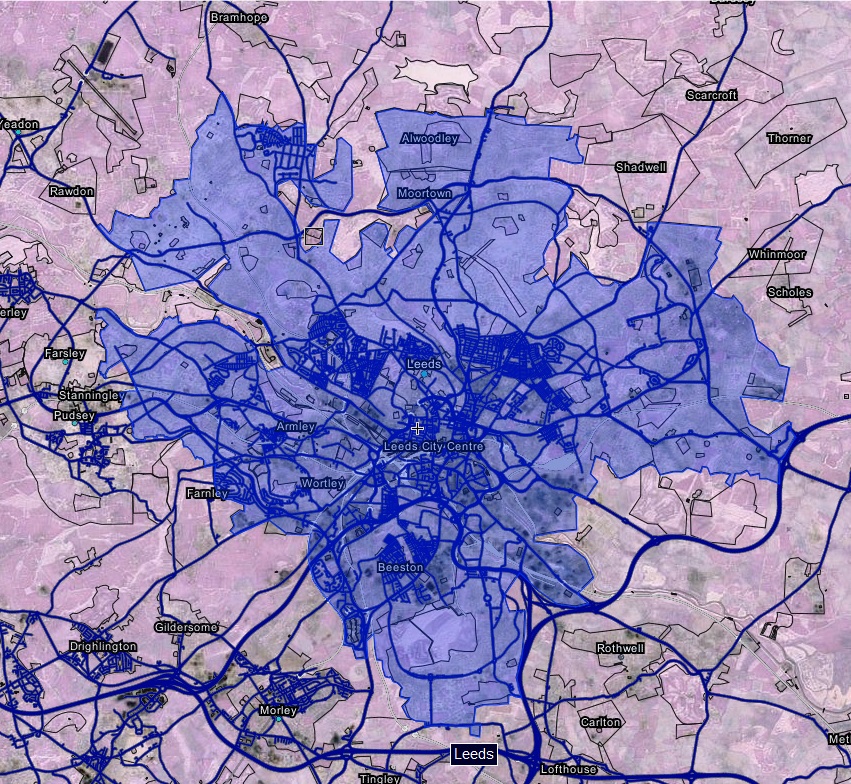Leeds
- England -x- Yorkshire -x- Knights of the World Tree - x- York
Quote
"You will never find a more wretched hive of scum and villainy. We must be cautious." ―- Obi-Wan Kenobi, to Luke Skywalker ... (Episode 4)
Appearance
City Device
Climate
Economy
The legitimate economy of Leeds is primarily tertiary industry: Call centers serving more affluent English-speaking countries are, collectively, the single largest source of employment in the city. Third-world style piece work manufacturing plays a large role as well. The region boasts a large and poorly paid service sector, as everyone else tries to eke out a living, leeching what little those lucky enough to have a job can spare.
Illegal, unregulated and untaxed industries far outperform the legitimate economy of Leeds, however. Designer drugs originate here, bound for countries around the world. At least two factories run by night only, turning out illegal, unmarked and unregistered arms and ammunition, bound for every active war zone and crime capita. The unfortunates who provide the labor, of course, are desperate individuals indeed.
Geography
Districts of Leeds
- -- Alwoodley --
- -- Alwoodley Gates --
- -- Armley -- is a district in the west of Leeds, West Yorkshire, England. It starts less than 1 mile (1.6 km) from Leeds city center. Like much of Leeds, Armley grew in the industrial revolution and had several mills, one of which is now the Armley Mills museum. Armley is predominantly and historically a largely working class area of the city, still retains many smaller industrial businesses, and has many rows of back-to-back terrace houses. -– Domain of Sydney Heath (Former Sheriff) http://wikimapia.org/#lang=en&lat=53.796583&lon=-1.603768&z=17&m=b
- -- Austhorpe --
- -- Beeston -- Beeston is a suburb of Leeds, West Yorkshire, England located about 2 miles (3 km) south of the city center. The area is separated from surrounding areas to the north, east and west by the M621 motorway.
- -- Beeston Hill --
- -- Belle Isle --
- -- Bradford -- Enjoy the open spaces of the Airedale and Wharfedale Valleys, then pay a visit to Haworth, the literary village associated with the Bronte sisters.
- -- Bramley --
- -- Burley --
- -- Carr Manor --
- -- Chapel Allerton --
- -- Chapeltown --
- -- Churwell --
- -- Clapham --
- -- Colton --
- -- Cookridge --
- -- Cross Gates --
- -- Famley --
- -- Farsley --
- -- Fearnville --
- -- Gipton --
- -- Gledhow --
- -- Green Hill --
- -- Halton --
- -- Harehills --
- -- Hawksworth --
- -- Holbeck --
- -- Holt Park --
- -- Horsforth --
- -- Hunslet --
- -- Hunslet Carr --
- -- Killingbeck --
- -- Kirkstall --
- -- Lawnswood --
- -- Leeds City Centre --
- -- Leeds Dock -- Leeds Dock (formerly New Dock and also known as Clarence Dock between 2001 and 2012) is a mixed development with retail, office and leisure presence in central Leeds, West Yorkshire, England. It has large residential population in waterside apartments.
- -- Lovell Park --
- -- Middleton --
- -- Monkswood --
- -- Moor Allerton --
- -- Moortown --
- -- Morley --
- -- New Famley --
- -- Oakwood --
- -- Osmondthorpe --
- -- Oulton --
- -- Potternewton --
- -- Primley Park --
- -- Pudsey --
- -- Richmond Hill --
- -- Robin Hood -- A village in West Yorkshire, England, within the City of Leeds metropolitan borough, with Wakefield WF3 postcodes. It is part of the Ardsley and Robin Hood ward, and in the new Morley and Outwood parliamentary constituency. It is on the A61 between Leeds and Wakefield, close to Rothwell and Lofthouse.
- -- Rodley --
- -- Roundhay --
- -- Seacroft --
- -- Shadwell --
- -- Stanningley --
- -- Stourton --
- -- Thorpe-on-the-Hill --
- -- Tinshill --
- -- Town of Rothwell --
- -- Victoria Quarter -- The Victoria Quarter is an upmarket shopping area in Leeds, England. It consists of three blocks situated between Briggate and Vicar Lane, comprising County Arcade, Cross Arcade, Queen Victoria Street and King Edward Street.
- -- Weetwood --
- -- Wigton Moor --
- -- Winmoor --
- -- Woodhouse --
- -- Woodhouse Moor -–
- -- Woodlesford --
- -- Wortley -- Wortley (pronounced Wurt-lee) is a district of Leeds, West Yorkshire, England. It begins one mile to the west of the city centre.
History
Introduction
The history of the Yorkshire region stretches back far beyond the rise of Leeds. For centuries, York stood as a bastion against Scotish marauders, only to be sacked and re-fortified anew. With the unification of Scotland and England in 1603, York's importance diminished. Over the next few centuries, it stagnated, its population disappearing to more prominent cities. With the rise of Leeds as an industrial power, York itself has become a town of 150,000, boasting culture and history, but no real importance.
Leeds is the product of industrial expansion and lasiez-faire economic policies, unchecked by any sense of social justice or moderation. The city rose from nowhere during the industrial revolution, replacing ancient York as the center of population on the Scottish frontier. As quickly as it rose, Leeds's industry faltered and fell to urban blight. In the early 21st century, it stands a smog-filled industrial wasteland, its declining population barely served by a crumbling infrastructure that was never truly able to support the population. Crumbling factories sit amid fields of toxic waste, and most residential blocks host two or three houses stripped of all valuables (particularly plumbing pipes and electrical wires), and occupied only by the homeless and desperate. Still, Leeds remains the core of England's third largest Urban Area, with an uncounted urban population that may push 1 million.
Origins
Loidis, from which Leeds derives its name, was anciently a forested area of the Celtic kingdom of Elmet. The settlement certainly existed at the time of the Norman conquest of England and in 1086 was a thriving manor under the over-lordship of Ilbert de Lacy. It gained its first charter from Maurice de Gant in 1207 yet grew but slowly throughout the medieval and Tudor periods. The town had become part of the Duchy of Lancaster and reverted to the crown in the medieval period, so was a Royalist stronghold at the start of the first English Civil War.
In the seventeenth and eighteenth centuries Leeds prospered and expanded as a center of the woolen industry and it continued to expand rapidly in the Industrial Revolution. Following a period of post industrial decline in the mid twentieth century Leeds' prosperity revived with the development of tertiary industrial sectors.
City Nomenclature
The name "Leeds" is first attested in the form "Loidis": around 731 Bede mentioned it in book II, chapter 14 of his Historia ecclesiastica, in a discussion of an altar surviving from a church erected by Edwin of Northumbria, located in "...regione quae vocatur Loidis" ('the region known as Loidis'). This was evidently a regional name, but it subsequently occurs in the 1086 Domesday Book denoting a settlement, in the later Old English form Ledes. The name is not Old English in form, so is presumably an Anglo-Saxonisation of an earlier Celtic name. It is hard to be sure what this name was; Mills's A Dictionary of British Place-Names prefers Celtic *Lādenses 'people living by the strongly flowing river'. It has been surmised that the name denoted a forest covering most of the kingdom of Elmet, which existed during the fifth century into the early seventh. An inhabitant of Leeds is locally known as a Loiner, possibly derived from Loidis.
Prehistoric Period to the Anglo-Saxon Age
There is no dependable reference to any place that might be associated with Leeds, before Bede's mention in circa 730 AD; and that was to a region rather than a village or town; thus little is known of any Roman or Anglo-Saxon predecessors to Leeds.
As well as scattered Bronze Age objects throughout the Leeds area, there were, according to 19th-century records, two Bronze Age barrows on Woodhouse Moor. In the pre-Roman and Roman Iron Age, the vicinity of Leeds was associated with the Brigantes; as well as possible Roman-period earthworks, a paved ford across the River Aire has been discovered, and is supposed to date to Roman times. Brigantian remains have been found in villages and towns in the vicinity of Leeds, and there are Roman remains in nearby settlements, notably at Adel, and at Alwoodley; in the suburb of Headingley a stone coffin was found in 1995 at Beckett's Park which is believed to date from Roman times.
Bede's account indicates activity in the vicinity of Leeds, though not necessarily near the town as it is now known: his unidentified place-name Campodonum might refer to an important place in the area; and one Abbot Thrythwulf had a monastery nearby in Bede's time, though it did not last long into the medieval period. However, evidence for major wealth and status comes from fragments of at least six stone crosses/other monuments, with the ninth- to tenth-century decoration characteristic of Anglo-Scandinavian culture, which were found in the fabric of the 14th-century Leeds Parish Church when it was demolished and replaced in 1838. The best preserved, now in the modern church, depicts alongside other images the story of Wayland the Smith. Leeds's profile was raised by the 2008-09 discovery of the West Yorkshire Hoard, a small, probably tenth- or eleventh-century treasure hoard of items from the early 7th century onwards, in the Leeds area. It seems likely that the Anglo-Saxon settlement consisted largely of an ecclesiastical site, a ford over the river Aire, and Kirkgate.
Other evidence for occupation in the Anglo-Saxon period lies in the old Shire Oak at Headingley, which is believed to have lent its name to the wapentake of Skyrack, and in the presence of many places around Leeds which have the termination of their names in ley: such as Bramley, Rodley, Farnley, Armley, Wortley, and Farsley, which is derived from the Anglo-Saxon leah, an open place in the wood.
Norman Period
Leeds parish is thought to have developed from a large British multiple estate which, under subsequent Anglo-Saxon occupation was further sub divided into smaller land holdings. The ancient parish encompassed Leeds, Headingley, Allerton, Gipton, Bramley, Armley, Farnley, Beeston and Ristone (Wortley). Leeds was the most important of these holdings. Leeds was then further sub divided so that when the first dependable historical record about Leeds (as "Ledes") was written in the Domesday book of 1086, it was recorded as having comprised seven small manors in the days of Edward the Confessor. At the time of the Norman conquest, Leeds was evidently a purely agricultural domain, of about 1,000 acres (4 km2) in extent. It was divided into seven manors, held by as many thanes; they possessed six ploughs; there was a priest, and a church, and a mill: its taxable value was six pounds. When the Domesday records were made, it had slightly increased in value; the seven thanes had been replaced by twenty-seven villains, four sokemen, and four bordars. The villains were what we should now call day-labourers: the soke or soc men were persons of various degrees, from small owners under a greater lord, to mere husbandmen: the bordars are considered by most specialists in Domesday terminology to have been mere drudges, hewers of wood, drawers of water. The mill, when this survey was made, was worth four shillings. There were 10 acres (40,000 m2) of meadow. The tenant in chief was Ilbert de Lacy to whom William the Conqueror had granted a vast Honour stretching widely across country from Lincolnshire into Lancashire, and whose chief stronghold was at Pontefract Castle, a few miles to the south-east.
That Leeds was owned by one of the chief favourites of William was fortunate; the probability is that the lands of the de Lacy ownership were spared when the harrying of the North took place. While the greater part of the county was absolutely destitute of human life, and all the land northward lay blackened, Leeds in 1086 had a population of at least two hundred people.
There were two significant foci to the settlement; the area around the parish church and the main manorial landholding half a mile to the west of the church. The Leeds Guide of 1837 states that Ilbert de Lacy built a castle on Mill Hill—roughly City Square in contemporary times—which was besieged by Stephen in his march towards Scotland in 1139. In 1399, according to the Hardynge Chronicle, the captive Richard II was briefly imprisoned at Leeds, before being transported to another de Lacy property at Pontefract, where he was later executed.
- "The kyng then sent kyng Richard to Ledis,"
- "there to be kepte durely in previtee;"
- "fro thens after to Pykering went he needis,"
- "and to Knaresbro' after led was he"
- "but to pontefrete last where he did dee."
In 1147, Cistercian monks settled at Kirkstall, and there from about 1152 began to build Kirkstall Abbey.
The First borough charter
Leeds was subinfeudated – along with much other land in Yorkshire, by the de Lacy family to the Paynel family; Ralph Paynel is mentioned often in the Domesday entries. He was one of the principal tenants-in-chief in Yorkshire. It was from a descendant of the Paynels, sometimes described as Maurice de Gant, that the inhabitants of Leeds received their first charter, in November, 1207. Leeds had the geographical advantages of being on a river crossing and being on the York to Chester route as well as being close to the Wharfedale to Skipton route through the Pennines. The manorial lords were keen to increase their revenues by exploiting these advantages.
The preamble of the charter reads:
- "I Maurice Paynall have given and granted and by this charter confirmed to my burgesses of Leeds and their heirs franchise and free burgage and their tofts and with each toft half an acre of land for tillage to hold these of me and my heirs in fief and inheritance freely quit and honourably rendering annually to me and my heirs for each toft and half an acre of land sixteen pence at Pentecost and at Martinmas."
The charter made various provisions for the appointment of a bailiff (prator) to preside over a court of justice, to collect rents and dues, and to fine recalcitrants; others stipulated for aids when the lord needed monetary help, and placed tenants under obligation to grind corn at his mill and bake in his oven. Leeds was granted some rights of self-government and it had burgesses who were freemen. Yet the charter granted to the townspeople of Leeds only the lowest conditions needed for urban development. It did not transform the manor into a borough but established a borough within a manor. It was not coextensive with the manor but consisted of only a group of tenements within it. The new town was laid out along the line of a street, later to be called Briggate, which was wide enough to hold a market, with about thirty burgage plots on either side. The south end of the street had a river crossing but the earliest recorded bridge, from which its name is derived (bridge gate), is in 1384. The population was small in 1207 and remained scanty for a long time afterwards. At the time of the Poll Tax of 1379 it appears not to have exceeded three hundred persons at the very outside; it was certainly one of the smallest towns in Yorkshire, such places as Snaith, Ripon, Tickhill, and Selby exceeding it in importance. Even in the thirteenth century, Leeds consisted of several distinct areas of habitation and activity. There was the old settlement around the parish church, the newly founded borough, the manor house and mill to the west and the town fields at Burmantofts (borough men's tofts). By establishing the borough the manorial revenues were increased and Leeds became more prosperous. Tax returns of 1334 and 1377 show that population of the whole parish before the Black Death was about 1,000 people of whom 350 to 400 lived in the central area including the borough. Leeds began to rank with the more prosperous towns to the east.
In 1217 Maurice de Gant lost the Leeds estate by figuring on the wrong side at the battle of Lincoln.His holding passed from him to Ranulf, Earl of Chester, and through him reverted to the de Lacy family; when the de Lacy estates became merged by marriage in the Duchy of Lancaster they passed to the royal family, and, on the accession of Henry IV, were absorbed into the possessions of the Crown.
During the Late Middle Ages
For four centuries after the Norman invasion, the growth of Leeds was slow. Its site had no particular military advantages: the great strategic position of that part of Yorkshire was at Pontefract, close by. It had, at first, no commercial values—it may have been that its first beginnings in its staple wool trade sprang from the wool growing of the Cistercians at Kirkstall Abbey, on its western borders. The township was concerned with little more than agriculture, and such trade as it knew was confined to those retailings which establish themselves wherever communities spring up—dealings in the necessities of life, which, reduced to a minimum, are merely food and clothing. The town itself was small—it was probably confined within a triangle formed on the lines of the present lower Briggate, Kirkgate, and the river Aire, with the parish church at one angle somewhere about, perhaps on, the site of the modern one. The streets would be narrow, unpaved and unlighted. The houses, in spite of the fact that stone is so plentiful in the district, were of wood, whitewashed, in many cases, thatched. All around the town lay the open fields and meadows, cultivated on the principle of strip-farming. And beyond these lay the forest of Elmet.
From the Tudor period to Incorporation
The Tudor period was a time of transition for Leeds, from a relatively mean settlement to a solid cloth-trading town. In 1470, it was obscure enough to be described as being "near to Rothwell", which in the fifteenth century had the rights of a market town. By 1536, when John Leland visited it, he was able to report of it that it was a pretty market town which stood most by clothing and was as large as Bradford, though not so "quik", by which he evidently meant not so enterprising. Nevertheless, much of the old life and conditions still existed. The Crown was now over-lord, and had been so ever since the accession of Henry IV, and the folk still ground their corn at the King's mills and baked their bread at the King's oven. There was as yet no charter of incorporation, and though the people were rapidly approaching to conditions of liberty their lot was still not very appreciably different from that of their forefathers. Up to the end of the sixteenth century Leeds may be looked upon as existing in semi-feudalism.
There is no mention of education in Leeds until 1552, when one William Sheafield, who seems to have been a chantry priest of St. Catherine in Leeds, left property in the town for the establishment of a learned school-master who should teach freely for ever such scholars, youths, and children as should resort to him, with the wise proviso that the Leeds folk themselves should find a suitable building and make up the master's salary to ten pounds a year. Here is the origin of Leeds Grammar School which, first housed in the Calls, and subsequently—through the beneficence of John Harrison—in Lady Lane, had by the end of that century become an institution of vast importance.
As the sixteenth century drew to a close, and while the seventeenth was still young, the towns-folk of Leeds secured in the first instance at their own cost, in the second by a strictly limited Royal favour two important privileges—the right of electing their own vicar and of governing themselves in municipal affairs. In 1583 the town bought the advowson of the parish church from its then possessor, Oliver Darnley, for £130, and henceforth the successive vicars were chosen by a body of trustees—the most notably successful experiment in popular election which has ever been known in the National Church. In 1626, Leeds received its first charter of incorporation from Charles I. The charter, premising that Leeds in the County of York is an ancient and populous town, whose inhabitants are well acquainted with the Art and Mystery of making Woollen Cloths, sets up a governing body of one Alderman, nine Burgesses, and twenty Assistants. But the privilege for some years was a limited one: the Crown reserved to itself the rights of appointment to any of the thirty vacancies which might occur by death: popular election did not come for some time.
First English Civil War and Population Explosion
Eighteen years after the granting of the charter of incorporation, Leeds joined with other towns in the neighbourhood in a Memorial to the King wherein he was besought to settle his differences with the rebellious Parliament. Of this no notice was taken, and in the earlier stages of the Civil War the town was garrisoned for the Royal cause under Sir William Savile. But it was a very small Leeds which he occupied for the King in January, 1643, having under him 500 horse and 1,500 foot. He made elaborate preparations for the defence of the place, digging a six-foot trench from St. John's Church by Upper Headrow, Boar Lane, and Swinegate to the banks of the river; erecting breastworks at the north end of the bridge, and placing demi-culverins in a position to sweep Briggate. Against him on Monday, January 23, advanced the redoubtable Sir Thomas Fairfax, at the head of a Parliamentary force which appears to have numbered at least 3000 horse and foot. Finding the bridge at Kirkstall broken down, Fairfax crossed the Aire at Apperley Bridge, and came on to Woodhouse Moor, from where he called on Savile to surrender. Savile returned the answer which was doubtless expected, and in the teeth of a heavy snowstorm, Fairfax led his troops forward to the assault. The action began about two o'clock of the afternoon and appears to have developed on all sides of the town. It rapidly went in favour of the assailants, and by four o'clock the Parliamentarian leaders and their troops were in Briggate and Boar Lane, while Savile and others were fleeing for their lives. Fairfax took nearly 500 prisoners and immediately released them on their promising not to take up arms against the Parliament on any further occasion. Though not a very great affair, it settled the question of King or Commons so far as that part of the West Riding was concerned.
The Puritan regime followed on the first successes of the Parliamentarians, and Leeds saw two Puritan ministers placed in the parish church and the new church of St. John. But in 1644 Leeds folk had something else to think: an epidemic, so serious as to rank with the medieval visitations of plague, broke out, and resulted in the death of 1300 inhabitants. The weekly markets were discontinued, and deaths occurred with such startling rapidity that it was impossible to keep pace with them in the parish registers.
In 1646 Charles I. came to Leeds a prisoner. After his surrender to the Scottish generals at Kelham, near Newark, he was led northward to Newcastle; on his return from that city, he spent one night in the house called Red Hall, in Upper Head Row.
It seems curious that up to the middle of the seventeenth century Leeds had never been directly represented in Parliament. Many now quite insignificant places in Yorkshire had sent members to the House of Commons from a very early period--Malton, Beverley, Northallerton had returned members as far back as 1298; Otley had had two members for centuries. But it was not until 1654 that Adam Baynes was returned to sit at Westminster; he was returned again two years later with Francis Allanson as a second member. This representation came to an end at the Restoration in 1660, and Leeds had no more members of Parliament until the Reform Act 1832. But in 1661 it received some concession from the Crown which was perhaps of more importance to it—a new Municipal Charter. There had been some readjustment of the old one in 1642, but Charles II's Charter was of a far-reaching nature. It set up a Mayor, twelve Aldermen, twenty-four Assistants or Councillors, a Town Clerk, and a Recorder; it also provided for local election to vacancies. From the Charter of Charles I and that of his son are derived the well-known arms of the town. The owls are the Savile owls famous throughout the county, where the Saviles have been legion; the mullets figured on the arms of Thomas Danby, first Mayor. The dependent sheep typifies the wool trade.
In 1715 the first history of Leeds was written by Ralph Thoresby, entitled Ducatus Leodiensis; or the Topography of the antient and populous Town and Parish of Leedes.
Leeds was mainly a merchant town, manufacturing woollen cloths and trading with Europe via the Humber estuary and the population grew from 10,000 at the end of the seventeenth century to 30,000 at the end of the eighteenth. As a gauge of the importance of the town, by the 1770s Leeds merchants were responsible for 30% of the country's woollen exports, valued at £1,500,000 when 70 years previously Yorkshire accounted for only 20% of exports.
Wool, Weaving and West Yorkshire
Weaving was introduced into West Yorkshire in the reign of Edward III, and Cistercians, such as at Kirkstall, were certainly engaged in sheep farming. Leland (date) records the organised trading of cloth on the bridge over the Aire, at the foot of Briggate, at specified times and under set conditions. The traded woollen cloth was predominantly of home manufacture, produced in the villages and settlements surrounding Leeds. (Bradford, by contrast, was the center of the worsted cloth trade.) There was, however, a fulling mill at Leeds by 1400, and cloth dying may also have been an early centralised activity. Before the time of Defoe's visit to Leeds, cloth trading outstripped the capacity of the bridge, and moved instead to trestle tables in up to two rows on each side of Briggate. Defoe mentions that at this time Leeds traders went all over the country, selling cloth on credit terms; and that an export trade existed. Ralph Thoresby was involved in the establishment of the first covered cloth market, when with others he secured the permission of the 3rd Viscount Irwin, holder of Manor of Leeds, to erect the White Cloth Hall. The fact of Wetherby having erected a trading hall in 1710 was almost certainly a driver of change. The new hall opened on 22 May 1711, and lasted for 65 years before being removed to a new site in the Calls, and later at the time of the railways to the present trading hall. In 1758 a coloured or mixed cloth hall was built near Mill Hill – a quadrangular building 66 yards (60 m) by 128 yards (117 m), with capacity for 1800 trading stalls, initially let at 3 guineas per annum, but later trading at a premium of £24 per annum. The hall was pulled down in 1899 to make way for the new General Post Office; the last White Cloth hall in 1896 to make way for the Metropole Hotel.
Industrial Revolution and Expansion
The industrial revolution had resulted in the radical growth of Leeds whose population had risen to over 150,000 by 1840. The city's industrial growth was catalysed by the introduction of the Aire & Calder Navigation in 1699, Leeds and Liverpool Canal in 1816 and the railways from 1834 onwards; the first being the Leeds and Selby Railway opened on 22 September 1834. The first Leeds railway station was at Marsh Lane; the Leeds Wellington station was opened in 1848; the Central in 1854, and the New station in 1869. Little by little the town was linked up with Hull, York, Sheffield, Bradford, Dewsbury; with the Durham and Northumberland towns; with Manchester and Liverpool; and with the Midlands and London.
In 1893 Leeds had been granted city status. These industries that developed in the industrial revolution had included making machinery for spinning, machine tools, steam engines and gears as well as other industries based on textiles, chemicals and leather and pottery. Coal was extracted on a large scale and the still functioning Middleton Railway, the first successful commercial steam locomotive railway in the world, transported coal into the centre of Leeds. The track was the first rack railway and the locomotive (Salamanca) was the first to have twin cylinders.
Various areas in Leeds developed different roles in the industrial revolution. The city center became a major center of transport and commerce, Hunslet and Holbeck became major engineering centers. Armley, Bramley and Kirkstall became milling centers and areas such as Roundhay became middle class suburbs, the building of the Leeds Tramway allowing them better connections with the rest of the city.
20th Century
By the 20th century this social and economic had started to change with the creation of the academic institutions that are known today as the University of Leeds and Leeds Beckett University. This period had also witnessed expansion in medical provision, particularly Leeds General Infirmary and St James's Hospital. Following the Second World War there has been, as in many other cities, a decline in secondary industries that thrived in the 19th century. However this decline was reversed in the growth of new tertiary industries such as retail, call centers, offices and media. Today Leeds is known as one of eight core cities that act as a focus of their respective regions and Leeds is generally regarded as the dominant city of the ceremonial county of West Yorkshire.
First World War
Leeds made notable contributions during the First World War. Yet suffered no military raids during the war. However, it did suffered significant losses in the form of young male volunteers, during the war.
The Barnbow Tragedy
Barnbow in Cross Gates was a large ammunitions factory producing ten thousand shells per week by August 1915. The worst tragedy ever to happen within Leeds (in terms of fatalities) happened at the Barnbow tragedy of 5 December 1916. 35 workers (all women aged 14 or over) were killed in the Barnbow Munitions Factory, which later became the Royal Ordnance Factory Barnbow. The plant employed 16,000 workers, from Leeds, Selby, Wakefield, Tadcaster and Wetherby and had its own railway station to cope with the daily influx of workers. The railway station had an 850-foot (260 m) platform and 38 special trains from surrounding towns and cities. An explosion from Hall 42 killed 35 workers and mutilated many more. Mechanic Mr William Parking was presented with an engraved silver watch for his bravery in saving factory workers during the incident.
The Pals of Leeds
During the First World War, regiments were made up of men from particular towns, meaning that if one regiment suffered heavy losses, a town or city would suffer heavy losses of its male population. Leeds was one city unfortunate enough to suffer this. By the Second World War, regiments weren't so geographically based. The battalion formed in 1914 and suffered its worse losses in the Battle of the Somme in 1916.
Second World War
During the Second World War Leeds made a further contribution to the war effort, although it was perhaps less historically notable than that of the first. Although the result of the sinking of the third Royal naval vessel named 'Ark Royal' which was Leeds's adopted ship the people of Leeds raised over £9 million in 1942 for a new ship, surpassing the £5 million target.
Leeds Blitz
Leeds escaped the worst of The Blitz, due mainly to its inland location and it not having any significant industrial targets. On the night of the 14 March and early hours of 15 March 1941, Leeds received its worst night of Luftwaffe bombing. Beeston had more bombs dropped on it then any other district of the city, yet escaped with the least damage. Flaxton Terrace was the only street to be damaged during the night-time blackout air raid, with nearly all the other bombs landing on Cross Flatts Park. In his 2005 poem 'Shrapnel' poet Tony Harrison, who was in Beeston on the night of the raid, speculates whether this was an act of heroism by the Luftwaffe pilot, a theory that has been explored ever since the raid. Significant damage was also caused in Holbeck and Headingley,[citation needed] while the Eastern side of the Town Hall was damaged. Bombs were also dropped on the Woodhouse area during nighttime air raids, as the Luftwaffe attempted to destroy an industrial target.
Thorp Arch Trading Estate
ROF Thorp Arch was the main munitions factory in the area at this time. The facility which is now a trading estate and retail park, was situated near Wetherby and like Barnbow featured significant railway facilities. The works suffered minor damage from bombing raids. People from all over West Yorkshire travelled to work at the facility by train from Leeds and Wetherby stations.
Yeadon
The town of Yeadon housed the underground factory that manufactured the parts for Avro Lancaster bombers. The factory was located alongside the current Leeds Bradford International Airport.
Rodley
Rodley to the west of the city had two factories, Smiths and Booths, that manufactured cranes, they were converted to make bombs.
21st Century
Population
2040 Statistical Estimate.
- -- City: 800,000 (town borders)
- -- West Yorkshire Urban Area: 2.4 Million (3rd largest in England after London and Birmingham).
The population of Leeds and the West Yorkshire Urban Area (as it is known to the UN) is generally poorer less well nourished than the average citizen of war-torn England. A small gentrified section has begun growing on the east end, populated largely by more affluent refugees from the more violent forms of gang violence in London.
Arenas
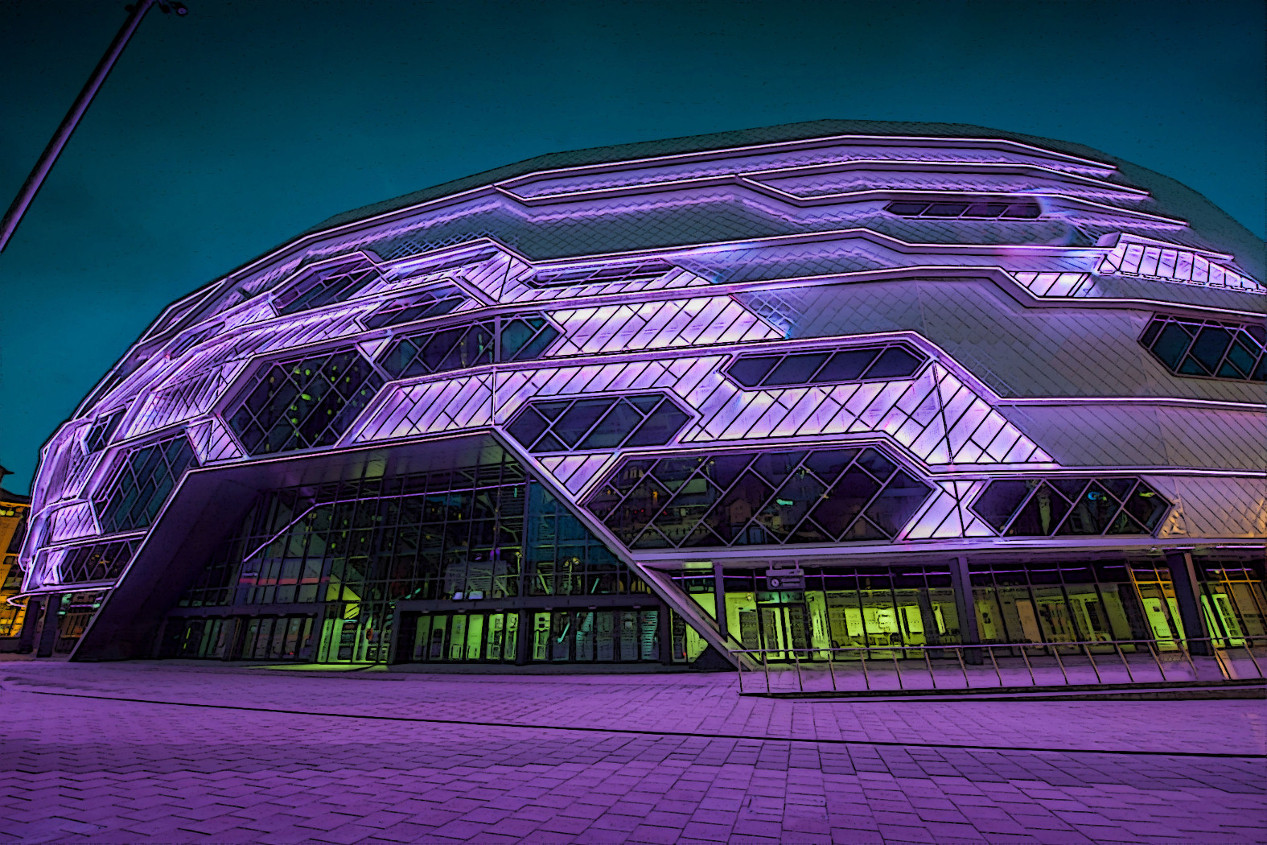
Leeds has a wealth of sports facilities including the 40,000 capacity Elland Road football stadium, a host stadium during the 1996 European Football Championship, 22,000 capacity Carnegie Headingley Stadium, world famous for both cricket and rugby league, South Leeds Stadium used for athletics, bowls, football, rugby league and tennis. Other facilities include the Leeds Wall (climbing), Xscape (real snow indoor ski and snowboard slope with ice climbing wall) and Yeadon Tarn, sailing center.
- -- Elland Road Stadium
- -- Headingley Carnegie Cricket Ground -- Home to Yorkshire County Cricket Club and the northernmost Test Ground in the world.
- -- Headingley Stadium
- -- First Direct Arena
- -- Leeds United F.C. Stadium
- -- South Leeds Stadium
- -- Wetherby Racecourse (horse racing)
Attractions
- -- Battlefield Leeds -- Leeds largest laser-tag battlefield.
- -- Leeds University Union
- -- Middleton Railway --
- -- Tick, Tock, Unlock -- A Live Escape Game.
Botanic Gardens
- -- Canal Gardens
- -- Tropical World
- -- York Gate Garden
Cemeteries
- -- <<>> --
- -- <<>> --
- -- Lawnswood Cemetery --
- -- <<>> --
- -- <<>> --
Cinema
- -- Cottage Road Cinema -- The Cottage Road Cinema is the oldest cinema in Leeds and one of the oldest cinemas in the UK in that it has been continuously showing films since 1912.
- -- Everyman Cinema Leeds -- The ultimate comfy cinema.
- -- Hyde Park Picture House -- Established in 1914, the Hyde Park Picture House is one of the UK's oldest cinemas. The Grade II listed building features gas lighting, an ornate balcony, comfy red chairs, operational 35mm projectors and a small snack kiosk. It shows the best independent, classic and award winning cinema from around the world, as well as family films every Saturday at 12noon and regular Baby screenings on Wednesdays at 11am. Please check website for upcoming listings.
City Government
- -- Leeds Town Hall --
- -- <<>> --
- -- <<>> --
- -- <<>> --
- -- <<>> --
Crime & Punishment
Criminals
- -- Dennis Slade -- Crime Boss -- Serving live sentence for armed robbery.
- -- Maxine Valentine -- Wife of Dennis Slade -- Jailed for money laundering.
- -- Harold Shipman -- Doctor and serial killer responsible for the murder of 250 patients.
- -- <<>> --
- -- <<>> --
- -- <<>> --
- -- <<>> --
- -- <<>> --
- -- <<>> --
- -- <<>> --
Hotspots
- -- Asda, Owlcotes (502)
- -- Morrisons, Hunslet (460)
- -- Primark, The Headrow (440)
- -- Tesco, Seacroft (344)
- -- Asda, Killingbeck (341)
- -- Space nightclub, city centre (327)
- -- Leeds Festival site at Bramham (326)
- -- St James’s Hospital (323)
- -- Briggate shopping precinct (285)
- -- Morrisons, Morley (111)
Prisons
- -- HM Prison Leeds -- Formerly known as Armley Gaol (or Armley Jail).
Underground Fighting
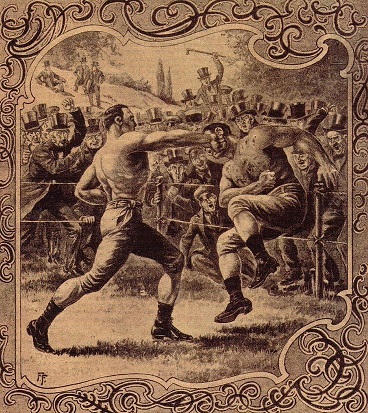
While barefisted fighting is popular through England from Berwick-upon-Tweed in the north to Penzance in the south-west, nowhere is barefisted fighting so popular as Leeds. The underground blood-sports of Leeds have been famous for decades, but recently the city's underground fighting has exploded into a black-market commodity and illicit entertainment. In a city where crime and violence are considered to be synonymous, the criminal element of Leeds has also opened the door to a means of escape from a life of endemic poverty and possibly to overnight affluence. But there is just one rule, everyone who wants to be anyone, must fight to prove his or her place in the city by the River Aire.
Citizens of the City
- -- <<Louis Le Prince>> -- deceased (c.1890)
- -- <<>> --
- -- <<>> --
- -- <<>> --
- -- <<>> --
- -- <<>> --
- -- <<>> --
- -- <<>> --
- -- <<>> --
- -- <<>> --
Current Events
- -- <<>> --
- -- <<>> --
- -- <<>> --
- -- <<>> --
- -- <<>> --
Fortifications
- -- <<>> --
- -- <<>> --
- -- <<>> --
- -- <<>> --
- -- <<>> --
Galleries
- -- Leeds Art Gallery --
- -- <<>> --
- -- <<>> --
- -- Stanley & Audrey Burton Gallery --
- -- Sunny Bank Mills Gallery -- This is an amazing space, full of Victorian Industrial atmosphere, but calming and serene.
Historic Sites
- -- Harewood House -- This popular stately home was built in the mid-18th century by John Carr, decorated by Robert Adam and furnished by Thomas Chippendale. Harewood has exhibitions of contemporary art, award winning gardens, a wide range of open-air events: from concerts to kite festivals, car rallies to craft fairs.
- -- Leeds Waterfront --
- -- Lotherton Hall --
- -- The Tetley -- An old and beautiful office building from a more elegant time.
- -- Turk's Head Yard --
- -- <<>> --
- -- <<>> --
- -- Yeadon Town Hall --
Holy Ground
- -- <<>> --
- -- <<>> --
- -- Holy Trinity Church Leeds --
- -- Leeds Cathedral --
- -- Leeds Parish Church --
- -- Mill Hill Chapel --
- -- St Anne's Roman Catholic Cathedral --
- -- St John's Church --
- -- <<>> --
- -- <<>> --
Hospitals
- -- <<>> --
- -- <<>> --
- -- <<>> --
- -- <<>> --
- -- <<>> --
Hotels & Hostels
- -- Malmaison in Leeds --
- -- <<>> --
- -- <<>> --
- -- <<>> --
- -- <<>> --
- -- <<>> --
- -- <<>> --
- -- <<>> --
- -- <<>> --
- -- Queens Hotel of Leeds -- The hotel is an elegant Art Deco Grade II listed building. It was remodeled and re-constructed in 1937 by architects W.Curtis Green and W.H. Hamlyn for the London, Midland and Scottish Railway (LMS). It is a four star hotel and it has a total of 215 rooms. It was acquired in 2003 by QHotels who gave it a £10 million makeover. Previous owners other than LMS and QHotels have included the publicly owned British Transport Hotels between 1948 and the early 1980s and latterly the Forte Group hotel and catering company.
Landmarks
- -- Bridgewater Place -- Bridgewater Place, nicknamed "The Dalek", is an office and residential skyscraper development in Leeds, West Yorkshire, England. It is the tallest building in Yorkshire, and has held this record since being topped out in September 2005. It is visible at up to 25 miles (40 km) from certain areas.
- -- City Square - Leeds --
- -- County Arcade --
- -- Leeds Corn Exchange --
- -- Leeds and Liverpool Canal --
- -- Leeds Town Hall --
- -- Millennium Square --
- -- Reclining Woman (Elbow) --
- -- The Waterfront Heritage Trail --
- -- Thwaite Mills --
- -- Woodhouse Moor -- Woodhouse Moor is an open space approximately one mile from Leeds city centre, West Yorkshire, England.
- -- Yeadon Tarn
Libraries
Maps
- -- A Map of Leeds in West Yorkshire
- -- <<>> --
- -- <<>> --
- -- <<>> --
- -- <<>> --
Market Places
- -- County Arcade --
- -- Granary Wharf -- Granary Wharf is a shopping center built in the brick tunnels underneath Leeds railway station and above the River Aire on Dark Neville Street in Leeds, West Yorkshire, England. The tunnel complex is known locally as the Dark Arches.
- -- Leeds Kirkgate Market -- Visit the largest indoor market in Europe, where Michael Marks opened his Penny Bazaar which led to the foundation of Marks and Spencer in 1890. -- {Elysium}
- -- <<>> --
- -- Thornton's Arcade --
- -- <<>> --
Media
- -- Yorkshire Evening Post --
- -- <<>> --
- -- <<>> --
- -- <<>> --
- -- <<>> --
Monasteries
- -- <<>> --
- -- <<>> --
- -- <<>> --
- -- <<>> --
- -- <<>> --
Monuments
- -- <<>> --
- -- <<>> --
- -- <<>> --
- -- <<>> --
- -- <<>> --
Museums
- -- Abbey House Museum -- Step back in time and wander through the enchanting streets, shops and houses and experience life as a Victorian. As a fun, family-friendly and interactive museum, Abbey House Museum is a great day out for all the family. Come to one of our many family sessions as advertised on our website or pop in with friends for a trip down memory lane.On the ground floor visit Stephen Harding Gate, the 19th century equivalent of a modern high street, for some old fashioned retail therapy. In the back streets, see the home of the window washer woman or pop into the Sunday-School. On the first floor, see our Childhood and Community Galleries along with the changing programme of exhibitions. Abbey House Museum is situated directly across the road from the historical site of Kirkstall Abbey, set in wonderful parkland along the banks of the River Aire.
- -- Dino Jaws
- -- Leeds City Museum -- Originally established in 1819, reopened on 13 September 2008. (Millennium Square) - {Elysium}
- -- Thackray Medical Museum -- The Thackray Medical Museum is one of the UK’s largest medical museums. We are a vibrant, inclusive and forward-looking charitable organisation, committed to educating, entertaining and inspiring people of all ages and abilities and from all walks of life, from primary school children to international scholars.
- -- The Royal Armouries -- Home for the national collection of arms and armour that features five theme-galleries: War, Tournament, Self-Defense, Hunting, and arms and armour of the Orient.
- -- Temple Newsam House -- One of the most celebrated historic houses in the country, this Tudor-Jacobean mansion has over forty restored rooms open to view. It is steeped in a rich history from its royal links to the lives of the ordinary people who lived and worked on the Estate.
Nightlife
Introduction: Since the heady days of the dance music explosion of the early nineties, Leeds has gained a well-deserved reputation as one of the UK's favourite clubbing destinations. Often described as the leading clubbing city outside of London, Leeds is best known as the home of pioneering club nights Back to Basics and Speedqueen, and is one of the country's most popular destinations for Stag and Hen Weekends.
- -- <<Call Lane>> -- One of the most popular areas in the city and home to plenty of trendy bars. It's a bit on the expensive side but worth a visit. You can find something to suit pretty much any music taste.
- -- <<Headingley>> -- Home to students from both Leeds Uni and Leeds Met Headingley is a bit of a mixed bag. There are plenty of cheap studenty bars and a few up-market cocktail bars too.
Bars and Clubs
- -- Arcadia Bar -- Another good place to try, but it is a bit small inside, however there's a good selection of beers and ciders. {A possible Fae hotspot?}
- -- Chilli White -- Three floors of pure decadence.
- -- Gangland -- The city's only known Vampyre Club.
- -- Majestyk -- The Erstwhile Most Famous Club in Leeds.
- -- O2 Academy Leeds -- Live Music, Gigs and Club Nights.
- -- Pryzm -- Formerly known as Oceana with Five Unique Themed Rooms.
- -- Space -- A dangerous nightclub.
- -- The Box -- Is usually a good call, although it gets ridiculously busy on weekends.
- -- The HiFi Club -- Three times winner of “Best Nightclub”.
- -- The Original Oak -- In summer it has a massive beer garden where you can chill out and watch whatever sport happens to be on and tuck into a good bbq. {Werewolf Bar??}
- -- Tiger Tiger -- Themed Nightclub and Restaurant.
- -- The Warehouse -- Re-opened with a Brand New Look.
- -- <<>> --
- -- <<>> --
- -- <<>> --
- -- <<>> --
- -- <<>> --
- -- <<>> --
- -- <<>> --
Alternative Venues
- -- <<Brudenell Social Club>> -- is a place where visitors can hear live local bands. Situated in Hyde Park near to the University of Leeds campus, it's very popular with students.
- -- <<Cockpit>> -- is massively popular with students. Regular alternative club nights and plenty of gigs. Worth a visit for cheap drinks and there aren't many bars hidden under railway bridges these days.
- -- <<Dry Dock>> -- If you've never been to a pub that's also a boat and is nowhere near a river then pub is your place. They do fab pub food and there's usually deals on drinks. Tuesdays are probably the busiest night of the week but then they're also the cheapest.
- -- <<Fab Cafe>> -- If you fancy somewhere a little bit different then this place is a good call. Hidden away in plain sight, it's has all sorts of film/tv memorabilia. There's always a cult film on and you can buy retro sweets too.
- -- <<Joseph’s Well>> -- is a live music bar popular with University of Leeds students. A bit of a trek from the city center, but there are usually good punk gigs etc on here.
- -- <<>> --
- -- <<>> --
- -- <<>> --
- -- <<>> --
- -- <<>> --
http://www.leeds-city-guide.com/clubs#.VH1ET8kVHcw
Parks
- -- Breary Marsh
- -- Chevin Forest Park
- -- Golden Acre Park --
- -- Hetchell Woods and Pompocali
- -- Meanwood Valley Trail
- -- Middleton Park -- Middleton Park is a large public park separating the neighborhoods of Beeston and Middleton. {Elysium}
- -- Park Square - Leeds -- Park Square is a Georgian public square in Leeds.
- -- Rodley Nature Reserve -- Rodley Nature Reserve is designed to bring wetland wildlife back into the Leeds area.
- -- Roundhay Park --
- -- Sri Chinmoy Peace Park -- {Elysium}
- -- St Aidan's RSPB reserve
Prisons
Private Residences
- -- <<>> --
- -- <<>> --
- -- <<>> --
- -- <<>> --
- -- <<>> --
Restaurants
- -- City Square --
- -- <<>> --
- -- <<>> --
- -- Seven Arts --
- -- <<>> --
Ruins
- -- Kirkstall Abbey -- Kirkstall Abbey is a ruined Cistercian monastery in Kirkstall north-west of Leeds city center. It is set in a public park on the north bank of the River Aire. It was founded c.1152. It was disestablished during the Dissolution of the Monasteries under the auspices of Henry VIII. The picturesque ruins have been drawn and painted by artists such as J.M.W. Turner, Thomas Girtin and John Sell Cotman. Kirkstall Abbey was acquired by Leeds Corporation as a gift from Colonel North and opened to the public in the late 19th century. The gatehouse became a museum.
- -- <<>> --
- -- <<>> --
- -- <<>> --
- -- <<>> --
- -- <<>> --
Schools
- -- <<Leeds Beckett University>> --
- -- <<Leeds College of Art>> --
- -- <<Leeds College of Building>> --
- -- <<Leeds City College>> --
- -- <<Leeds College of Music>> --
- -- <<Notre Dame Catholic Sixth Form College at Leeds>> --
- -- <<Northern School of Contemporary Dance at Leeds>> --
- -- <<Leeds Trinity University>> --
- -- <<SLP College Leeds>> --
- -- <<University of Leeds>> --
Shops
- -- Harvey Nichols -- Graced with designer labels such as Prada, Gucci, Dolce and Gabbana this store is renowned for those wishing to indulge in serious retail therapy.
- -- Leeds Kirkgate Market --
- -- <<>> --
- -- <<>> --
- -- <<>> --
Sports
- -- Howley Hall Golf Club --
- -- <<>> --
- -- <<>> --
- -- <<>> --
- -- <<>> --
- -- <<>> --
Theaters
- -- Hyde Park Picture House of Leeds -- The oldest surviving and still active gaslight theater in England.
- -- Leeds City Varieties Music Hall -- Built in 1865 above the White Swan public house in Swan Street Leeds. Most famous for hosting BBC's The Good Old Days for 30 years. The City Varieties Music Hall has a varied programme of Comedy, Music, Variety, Family shows and Pantomime.
- -- Grand Theatre -- Situated in the heart of Leeds, the Grand Theatre opened in 1878 and has been entertaining people ever since. With a wide programme from musicals to stand-up, opera to drama and ballet to family shows, there's bound to be something that you'll enjoy.
- -- West Yorkshire Playhouse --
Transportation
- -- Leeds Bradford International Airport -- Leeds Bradford International Airport is located at Yeadon, in the City of Leeds Metropolitan District in West Yorkshire, England, 6 nautical miles (11 km; 6.9 mi) northwest of Leeds city center. It serves the cities of Leeds and Bradford, as well as the wider Yorkshire region including the cities of York and Wakefield, and is the largest airport within Yorkshire. The airport was in public ownership until May 2007, when it was sold for £145.5 million to Bridgepoint Capital.
- -- Leeds City Railway Station -- Leeds City railway station is the mainline railway station serving the city center of Leeds in West Yorkshire, England. It is the second busiest railway station in England outside of London. It's located on New Station Street to the south of City Square, at the bottom of Park Row, behind the landmark Queens Hotel.
- -- <<>> --
- -- <<>> --
- -- <<>> --
Vampires of Leeds (31)
The Kindred of Leeds are almost completely the negative image of the effete vampires of London, here the Low Clans hold the power, but the undead of Leeds have broken the mold by becoming the stereotypes of British criminal noir.
Vampiric History
Yohanus of Eboracum (known in later eras as John of York) was the first to rally to Mithras's side against the Triumvirate. In his view, he was never properly rewarded for this act of trust and faith. In a letter copied to all kindred of note in the isles, John accused Mithras of failing to properly honor his liege-men, and declared his alliance with Robert the Scot and the Courts of Love. John and his followers were crushed and the Barony of York passed to the warlike Gangrel Willem Dowd.
Dowd survived the destruction of his sire Aethelwulf by the Toreador of Edinburgh during the last decade of the 15th century. He remained a strong threat against Scottish intransigence for more than two centuries. As his eyes remained focused north, however, he ignored the changes happening within his own domain. Anarchs and Sabbat streamed into the growing population center of Leeds. The Sabbat laid siege to York from their de-facto stronghold in Leeds in 1883. Dowd survived long enough to lay the blame squarely at the feet of Edinburgh, then succumbed to the hordes of the Black Hand.
The powers that be in London panicked (and Lady Anne dearly wanted to rid the city of a number of rivals and troublemakers). Mithras himself directed the Camarilla response. Aldous Tope, a childe and strong supporter of former seneschal Valerius, became Baron of York and Prince of Leeds. The new Baron ruled with the support of a large cohort of relatively young Londoners and their recently embraced local childer.
From 2029 to 2041, the Sabbat, using recently occupied London as a base, attacked several cities in Britain. While some fared better than others, none fared so badly as Leeds. Sensing an opportunity, Sabbat refugees from London and their reinforcements from around the world flocked to the crime-ridden industrial wasteland not unlike the cities, such as Detroit, they were used to. It wasn't until refugees began trickling into London that the powers of Avalon realized that Prince Trope had fallen and the Sabbat occupied Leeds. The northern Baronies, seeing a wolf in their midst, protested, but lacked the strength to dislodge the Sabbat themselves.
In 2032, Brian O'Reilly rallied support from Avalon and the northern Baronies. He and his Knights of the World Tree provided the brunt of the manpower, and drove the disorganized Sabbat from their new strongholds in Leeds. Baron Brian chose to return the seat of Yorkshire to York, placing a Reeve in power in Leeds. Thorton Bryant of Clan Ventrue administered Leeds in O'Reilly's name from 2032 to 2042.
Current & Former Domains
- -- Armley -- Former domain of Sydney Heath (Former Sheriff) is a district in the west of Leeds, West Yorkshire, England. It starts less than 1 mile (1.6 km) from Leeds city center. Like much of Leeds, Armley grew in the industrial revolution and had several mills, one of which is now the Armley Mills museum. Armley is predominantly and historically a largely working class area of the city, still retains many smaller industrial businesses, and has many rows of back-to-back terrace houses. (http://wikimapia.org/#lang=en&lat=53.796583&lon=-1.603768&z=17&m=b)
- -- Beeston -- Cross Flats Park and the surround neighborhood in Beeston - Rikko (Nosferatu Primogen) http://wikimapia.org/#lang=en&lat=53.787646&lon=-1.543815&z=16&m=b
- -- Bradford -- (West of Leeds) -- The city is still an open domain.
- -- Gledhow -- A small area centered on the Yorkshire AFC stadium – Bloodhardt (Gangrel) http://wikimapia.org/#lang=en&lat=53.823538&lon=-1.521403&z=17&m=b
- -- Leeds City Centre -- The Rack
- -- A small section of Leeds City Center south of Sri Chinmoy Peace Park – Keller Williams (Malkavian Primogen) http://wikimapia.org/#lang=en&lat=53.797837&lon=-1.552666&z=17&m=b
- -- Quarry House, West Yorkshire Playhouse and a few blocks of the surrounding region – Alexander Tatum (Keeper, former Toreador Primogen). http://wikimapia.org/#lang=en&lat=53.795670&lon=-1.530147&z=16&m=b
- -- Middleton -- A residential district of Leeds south of Middleton Park – Roderick Smith (Caitiff leader of Rod’s Crew). http://wikimapia.org/#lang=en&lat=53.744593&lon=-1.530919&z=17&m=b
- -- Morley -- (SE of Leeds proper) -- Formerly the domain of Harold Reeve (Former Ventrue Primogen), the current domain of the Baron of Yorkshire.
- ---- <<Asquith Primary School>> -- Morley -- (closed for 20 years) -- Domain of Scotty Nails (Gangrel Mercenary). http://wikimapia.org/#lang=en&lat=53.753177&lon=-1.611772&z=17&m=b
- -- Shadwell -- A new gated community in the district of Shadwell (Just north of the 2015 developed area). Gloriana Anson (Former Keeper, now Ventrue Primogen). http://wikimapia.org/#lang=en&lat=53.853875&lon=-1.475451&z=17&m=b
- -- Town of Rothwell -- A housing complex in south-East Leeds: - Finnan Beirne (Brujah former Mercenary, for his service during the Siege of Leeds). http://wikimapia.org/#lang=en&lat=53.748248&lon=-1.470972&z=18&m=b
- -- Weetwood -- A Lawnswood Cemetary and Surrounding neighborhood: Tadeo Giovanni, in the name of the residents of his clan. http://wikimapia.org/#lang=en&lat=53.848046&lon=-1.596365&z=16&m=b
- -- Woodhouse Moor -– Tristram Young. (Scourge)
- -- Wortley -- Wortley (pronounced Wurt-lee) is a district of Leeds; it begins one mile to the west of the city center. Formerly a residential district including Wortley High School and North of Western Flats Park, part of the Wortley neighborhood belonged to the now banished, former Brujah primogen Balfor Laver. (http://wikimapia.org/#lang=en&lat=53.788863&lon=-1.600056&z=15&m=b)
Leeds City Centre -- The Rack
Announcements & Proclamations
The Privy Council of Leeds (circa: 2042)
- -- Brian O'Reilly -- Ventrue Baron of Yorkshire, Prince of Leeds, and founder of the Knights of the World Tree.
- -- Keller Willams -- Primogen for the Malkavians (present at meetings from astral-projection).
- -- Rikko - Nosferatu Primogen.
- -- Gloriana Anson -- Primogen for the Ventrue.
- -- Blood-Heart - A Pict warrior recently awakened from torpor, he is the rightful primogen of Beasts.
Vampiric Officials of Leeds (circa: 2042)
- -- Samuel Scott -- The new Seneschal of Leeds.
- -- Alexander Tatum -- Keeper of Elysium (the former Primogen of the Hedonists, his fall from power has become his saving grace).
- -- Gulliermo Suarez -- Assamite Sheriff of Leeds.
- -- Tristram Young -- Scourge of Leeds.
 Assamite
Assamite
- -- Gulliermo Suarez -- Assamite Sheriff of Leeds.
 Brujah
Brujah
- -- Finnan Beirne -- Irish former mercenary with Anarch sympathies.
 Caitiff
Caitiff
Rod's Crew: This group of violent, some say desperate, Caitiff earned a place in Leeds by facing the Sabbat on their own terms and winning. The losses they took only add to their sense of entitlement. Of course, the last ten years of peace has given more effete vampires the chance to wonder if Leeds needs a group of armed mercenaries. This sentiment is only exacerbated by the condition of their domain; one of the most violent and poverty-stricken neighborhoods in a generally violent and poverty-stricken city.
- -- Rodrick Smith - "Iron Rod:" Leader of the Crew
- -- Sanjay Goswami
- -- Kishori Damisi
- -- Kyle MacQueen
- -- Rita Doscampos
 Gangrel
Gangrel
- -- Blood-Heart -- An Pict warrior recently awakened from torpor, he is the rightful primogen of Beasts.
- -- Erin Noah -- Naturalist and Eco-warrior.
- -- Scotty Nails -- Gangrel mercenary
- -- John Johnson -- Underworld Enforcer.
- -- Tristram Young -- Welsh neonate Gangrel from Llandrindod Wells; he was the scourge under the old prince and retains that position tonight.
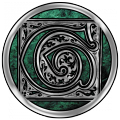 Giovanni
Giovanni
- -- Taddeo Giovanni - Don of Leeds, and a wild-card in the city's underworld struggles.
- -- Alonzo Giovanni - Taddeo's Chief Enforcer.
- -- Frederico Giovanni - Master Reaper. {Missing}
- -- Jonathan Dunsirn - Cannibal Necromancer and agent of Ambrogino Giovanni. {Missing}
- -- Roulo Putanesca - Taddeo's primary bodyguard.
- -- Robert Dunsirn - Dunscirn Neonate and financial genius. Childe of Alonzo Giovanni.
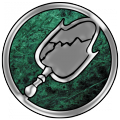 Malkavian
Malkavian
- -- Keller Willams -- Malkavian Primogen (home bound).
- -- Chelsea Fischer --
 Nosferatu
Nosferatu
- -- Rikko -- Nosferatu Primogen. Childe of Baroness Citrine Greene of Lincoln.
- -- Regina Horst -- Childe of Rikko, and mistress of the Dumps. {In Torpor}
- -- Grinchie -- Childe of Rikko, and master of the sewers. {In Torpor}
 Ravnos
Ravnos
- -- Albus Le Pus -- Jongleur Extraordinaire and recent arrival.
 Toreador
Toreador
- -- Alexander Tatum - Former Toreador Primogen, premier Poseur and new Keeper of Elysium.
- -- Mer Tarrin - Androginous Pop Artist, childe of Alexander Tatum
- -- Mac Verser - Painter and follower of the Road of Chivalry.
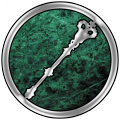 Ventrue
Ventrue
Those Ventrue of Leeds descended from Sydney Heath are British gangsters one and all. Some like Oldman Forseby have the style and intelligence to make crime-lord mean somthing, while others, like Edgar Trigg are thugs who live for the attention that accompany violence and wealth.
- -- Brian O'Reilly - Baron of Yorkshire, Prince of Leeds, and founder of the Knights of the World Tree.
- -- Hans Holgersson - Fledgling Childe of Brian O'Reilly. {Temporary Resident of Leeds}
- -- Gloriana Anson -- Primogen for the Ventrue.
- -- Samuel Scott -- Stock-market genius, hero of Avalon and the new Seneschal of Leeds.
Old Announcements & Proclamations
- -- Reeve Blake's First Letter -- The new reeve's regnal letter to the Kindred of Leeds (June 20th, 2042).
- -- Proclamation: Midsummer's Night Hunt 2042
 Those Banished from York
Those Banished from York
Rebellious Rabble
- -- Balfor Laver - Brujah Primogen and crimelord.
- -- John Jones Childe of Balfor Laver – A forgetable killer.
- -- Enoch Zephyr SE Asian religious rebel, childe of Balfor Laver.
- -- Trista Nichole Childe of John Jones: Slightly psychotic former barmaid brawler.
Boisterous Blue Bloods
- -- Harold Lord Reeve - Ventrue Primogen, childe of Baron Shawlands of Manchester.
- -- Patience Adams Eldest childe of Harold Reeve.
- -- Ignacius Nelson - Middle Childe of Harold Reeve. "Nate".
- -- Samantha Brennan - Youngest childe of Harold Reeve.
 The Dead Vampires of Leeds
The Dead Vampires of Leeds
- -- Aldous Tope -- Ventrue Baron of York and Prince of Leeds, 1890 - 2029
Websites
http://www.yorkshire-england.co.uk/Leeds.html (The history of Leeds)
http://leeds-list.com/opinion/best-and-worst-places-to-live-in-leeds/
https://en.wikipedia.org/wiki/Kaiser_Chiefs (local rock band)
http://www.tripadvisor.com/Attractions-g186411-Activities-Leeds_West_Yorkshire_England.html (300+ Things to do in Leeds)
http://www.tripadvisor.com/Travel-g186411-s402/Leeds:United-Kingdom:Nightlife.html (Nightlife)
http://www.tripadvisor.com/Travel-g186411-s408/Leeds:United-Kingdom:Events.And.Festivals.html (Events & Festivals)
http://flickrhivemind.net/Tags/leeds,memorial/Interesting (Pictures)
http://www.28dayslater.co.uk/forums/index.php {28 Days Later - Urban Exploration} *****
https://en.wikipedia.org/wiki/British_slang
https://en.wikipedia.org/wiki/Romanichal
https://en.wikipedia.org/wiki/Peaky_Blinders_%28TV_series%29
http://www.stuartwaltonart.com/page4.htm {19th Century Photographs}
https://en.wikivoyage.org/wiki/Leeds
http://www.knowhere.co.uk/Leeds/West-Yorkshire/Northern-England/info/worstthings {The worst things about Leeds from the local British point of view.}
http://www.ukcrimestats.com/Constituency/65765 {Crime in Leeds: 2013 - 2015 statistics}

